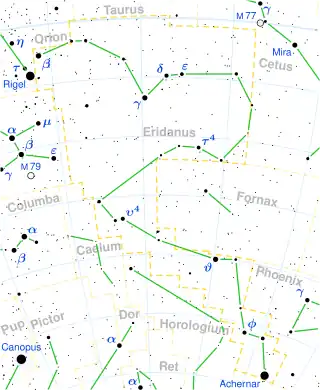Delta Eridani
Delta Eridani, which is Latinized from δ Eridani, is a star in the equatorial constellation of Eridanus.
 | |
| Observation data Epoch J2000 Equinox J2000 | |
|---|---|
| Constellation | Eridanus |
| Right ascension | 03h 43m 14.90088s[1] |
| Declination | –09° 45′ 48.2084″[1] |
| Apparent magnitude (V) | 3.51 - 3.56[2] |
| Characteristics | |
| Evolutionary stage | Subgiant |
| Spectral type | K0 IV[3] |
| U−B color index | +0.69[4] |
| B−V color index | +0.92[4] |
| Variable type | Suspected RS CVn[2] |
| Astrometry | |
| Radial velocity (Rv) | −6.28±0.09[5] km/s |
| Proper motion (μ) | RA: −93.16[1] mas/yr Dec.: +743.64[1] mas/yr |
| Parallax (π) | 110.61 ± 0.29 mas[1] |
| Distance | 29.49 ± 0.08 ly (9.04 ± 0.02 pc) |
| Absolute magnitude (MV) | 3.77[6] |
| Details[7] | |
| Mass | 1.33±0.07 M☉ |
| Radius | 2.327±0.029 R☉ |
| Luminosity | 3.00±0.12 L☉ |
| Surface gravity (log g) | 3.77±0.08 cgs |
| Temperature | 4,986±57 K |
| Metallicity [Fe/H] | +0.15±0.07 dex |
| Rotational velocity (v sin i) | 0.7±0.6 km/s |
| Age | 6.194[8] Gyr |
| Other designations | |
| Database references | |
| SIMBAD | data |
The star is visible to the naked eye and has been observed to vary slightly in brightness between magnitudes 3.51 and 3.56,[2] although subsequent observations did not bear this out.[10] It is relatively near to the Sun, with a distance of about 29.5 light years as determined from parallax.[1] The star is drifting closer with a radial velocity of −6 km/s.[5]
Delta Eridani is sometimes called Rana:[11] Rana means "the frog" in Latin, but derivation of this name is uncertain. The name was approved by the International Astronomic Union on 4 April 2022.[12]
Structure
The stellar classification of this star is K0 IV,[3] matching a subgiant star that has exhausted its core hydrogen. This has caused the star to expand and become cooler than a comparable main sequence star. Stellar modelling indicates it is near the end of the subgiant stage and about to transition into a giant. It is an estimated six[8] billion years old with 33% more mass than the Sun. The star has 2.3 times the girth of the Sun and is radiating three times the Sun's luminosity from its photosphere at an effective temperature of 4,986 K.[7]
Delta Eridani is catalogued as a suspected RS Canum Venaticorum variable in 1983,[13] but the activity level for the star is so low that this is considered doubtful. This class of variables occurs in close binary systems. A low projected rotational velocity of under 1 km/s and the lack of radial velocity variation suggests that this putative variable is being viewed from nearly pole-on. However, an examination of the star using interferometry does not detect the presence of a companion at the expected distance.[8]
Chinese name
In Chinese, 天苑 (Tiān Yuàn), meaning Celestial Meadows, refers to an asterism consisting of δ Eridani, γ Eridani, π Eridani, ε Eridani, ζ Eridani, η Eridani, π Ceti, τ1 Eridani, τ2 Eridani, τ3 Eridani, τ4 Eridani, τ5 Eridani, τ6 Eridani, τ7 Eridani, τ8 Eridani and τ9 Eridani.[14] Consequently, the Chinese name for δ Eridani itself is 天苑三 (Tiān Yuàn sān, English: the Third Star of Celestial Meadows.)[15]
References
- van Leeuwen, F. (2007). "HIP 17378". Hipparcos, the New Reduction. Retrieved 2009-12-11.
- Samus', N. N; et al. (2017). "General catalogue of variable stars". Astronomy Reports. GCVS 5.1. 61 (1): 80. Bibcode:2017ARep...61...80S. doi:10.1134/S1063772917010085. S2CID 125853869.
- Spinrad, Hyron; Taylor, Benjamin J. (1969). "Scanner Abundance Studies. I. an Investigation of Supermetallicity in Late-Type Evolved Stars". Astrophysical Journal. 157: 1279. Bibcode:1969ApJ...157.1279S. doi:10.1086/150154.
- Mermilliod, J.-C. (1986). "Compilation of Eggen's UBV data, transformed to UBV (unpublished)". Catalogue of Eggen's UBV Data. Bibcode:1986EgUBV........0M.
- Jofré, E.; et al. (2015). "Stellar parameters and chemical abundances of 223 evolved stars with and without planets". Astronomy & Astrophysics. 574: A50. arXiv:1410.6422. Bibcode:2015A&A...574A..50J. doi:10.1051/0004-6361/201424474. S2CID 53666931.
- Pizzolato, N.; et al. (September 2000). "Evolution of X-ray activity of 1-3 Msun late-type stars in early post-main-sequence phases". Astronomy and Astrophysics. 361: 614–628. Bibcode:2000A&A...361..614P.
- Bruntt, H.; et al. (July 2010). "Accurate fundamental parameters for 23 bright solar-type stars". Monthly Notices of the Royal Astronomical Society. 405 (3): 1907–1923. arXiv:1002.4268. Bibcode:2010MNRAS.405.1907B. doi:10.1111/j.1365-2966.2010.16575.x. S2CID 118495267.
- Thévenin, F.; et al. (June 2005). "VLTI/VINCI diameter constraints on the evolutionary status of δ Eri, ξ Hya, η Boo". Astronomy and Astrophysics. 436 (1): 253–262. arXiv:astro-ph/0501420. Bibcode:2005A&A...436..253T. doi:10.1051/0004-6361:20042075. S2CID 118169489.
- "Del Eri". SIMBAD. Centre de données astronomiques de Strasbourg. Retrieved 2021-01-11.
- Eaton, J. A.; Poe, C. H. (April 1985). "Limits on the Variability of epsilon Eridani and delta Eridani". Information Bulletin on Variable Stars. 2712: 1. Bibcode:1985IBVS.2712....1E.
- Bečvář, A. (1951). Atlas Coeli Skalnaté Pleso II - Katalog 1950.0. Přírodovědecké Vydavatelstrí. p. 277. Retrieved 27 May 2019.
- "Naming Stars".
- Fisher, G. F.; et al. (January 1983). "Delta Eridani: a Very Bright New Variable Star". Information Bulletin on Variable Stars. 2259: 1. Bibcode:1983IBVS.2259....1F.
- (in Chinese) 中國星座神話, written by 陳久金. Published by 台灣書房出版有限公司, 2005, ISBN 978-986-7332-25-7.
- (in Chinese) 香港太空館 - 研究資源 - 亮星中英對照表 Archived January 30, 2011, at the Wayback Machine, Hong Kong Space Museum. Accessed on line November 23, 2010.
External links
- Kaler, James B. "RANA (Delta Eridani)". STARS. Retrieved 2021-01-11.
- "Rana". SolStation Company. Retrieved 2021-01-11.
- nStars entry